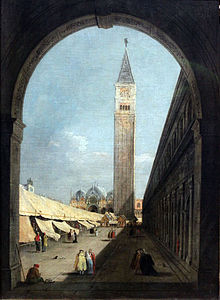
Giovanni Antonio Canal, commonly known as Canaletto, was an Italian painter from the Republic of Venice, considered an important member of the 18th-century Venetian school.

Giovanni Battista Tiepolo, also known as GiambattistaTiepolo, was an Italian painter and printmaker from the Republic of Venice who painted in the Rococo style, considered an important member of the 18th-century Venetian school. He was prolific, and worked not only in Italy, but also in Germany and Spain.

Giacomo Balla was an Italian painter, art teacher and poet best known as a key proponent of Futurism. In his paintings, he depicted light, movement and speed. He was concerned with expressing movement in his works, but unlike other leading futurists he was not interested in machines or violence with his works tending towards the witty and whimsical.
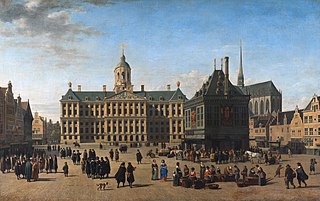
In the visual arts, a cityscape is an artistic representation, such as a painting, drawing, print or photograph, of the physical aspects of a city or urban area. It is the urban equivalent of a landscape. Townscape is roughly synonymous with cityscape, though it implies the same difference in urban size and density implicit in the difference between the words city and town. In urban design the terms refer to the configuration of built forms and interstitial space.

Francesco Lazzaro Guardi was an Italian painter, nobleman, and a member of the Venetian School. He is considered to be among the last practitioners, along with his brothers, of the classic Venetian school of painting.

Ca' Rezzonico is a palazzo and art museum on the Grand Canal in the Dorsoduro sestiere of Venice, Italy. It is a particularly notable example of the 18th century Venetian baroque and rococo architecture and interior decoration, and displays paintings by the leading Venetian painters of the period, including Francesco Guardi and Giambattista Tiepolo. It is a public museum dedicated to 18th-century Venice and one of the 11 venues managed by the Fondazione Musei Civici di Venezia.

Pietro Longhi was a Venetian painter of contemporary genre scenes of life.

Giovanni Antonio Guardi, also known as Gianantonio Guardi, was an Italian painter and nobleman. Guardi was one of the founders of the Venetian Academy in 1756.
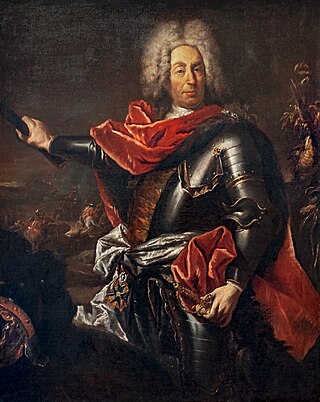
Marshal Johann Matthias Reichsgraf von der Schulenburg was a German aristocrat and general of Brandenburg-Prussian background who served in the Saxon and Venetian armies in the early 18th century and found a second career in retirement in Venice, as a grand collector and patron. His sister was Melusine von der Schulenburg, Duchess of Kendal. His father was Gustavus Adolphus, Baron von der Schulenburg.
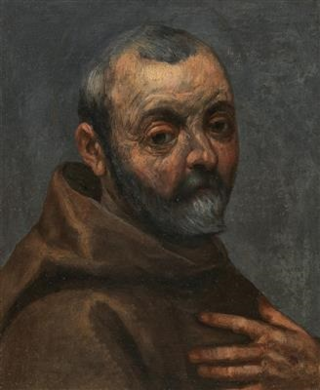
Iacopo Negretti, best known as Jacopo or Giacomo Palma il Giovane or simply Palma Giovane, was an Italian painter from Venice and a notable exponent of the Venetian school.

Francesco Maffei was an Italian painter, active in the Baroque style.
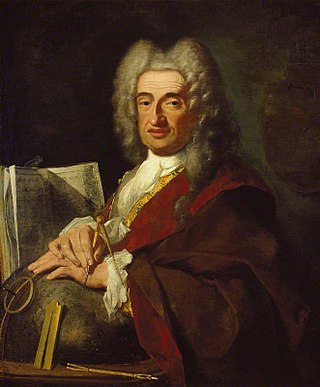
Luca Carlevarijs or Carlevaris was an Italian painter and engraver working mainly in Venice. He pioneered the genre of the cityscapes (vedute) of Venice, a genre that was later widely followed by artists such as Canaletto and Francesco Guardi.

The Chiesa dell'Angelo Raffaele is a church in Venice, northern Italy, located in the Dorsoduro sestiere. San Raffaele Arcangelo church is one of the only two churches in Venice that are possible to walk all around. It is located in Dorsoduro neighbourhood, close to San Basilio water bus stop.
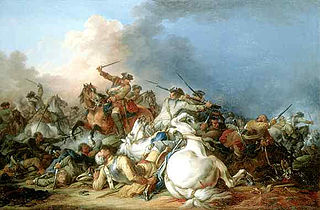
Francesco Giuseppe Casanova was an Italian painter who specialised in battle scenes. His older brother was Giacomo Casanova, the famous adventurer, and his younger brother was Giovanni Casanova; also a well-known painter.

Venetian painting was a major force in Italian Renaissance painting and beyond. Beginning with the work of Giovanni Bellini and his brother Gentile Bellini and their workshops, the major artists of the Venetian school included Giorgione, Titian, Tintoretto (1518–1594), Paolo Veronese (1528–1588) and Jacopo Bassano (1510–1592) and his sons. Considered to give primacy to colour over line, the tradition of the Venetian school contrasted with the Mannerism prevalent in the rest of Italy. The Venetian style exerted great influence upon the subsequent development of Western painting.
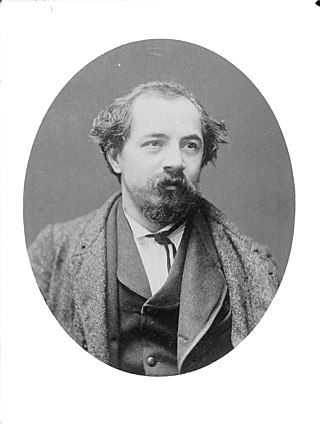
Tranquillo Cremona was an Italian painter. His paintings have a windswept style, lacking the linearity of Francesco Hayez and other academics; reminiscent of the Venice School and Titian.
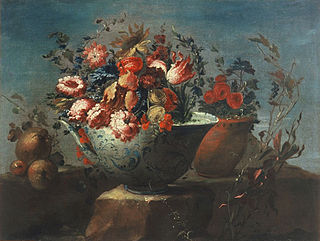
Francesco Duramano was an Italian painter known for floral still lifes. He was born in Venice, and active there and in Brescia.

Gian Giacomo Poldi Pezzoli was an Italian count who gathered art from Italian Renaissance. Italys' first private museum which bears his name, the Museo Poldi Pezzoli.

View of the Cannaregio Canal is a small oil-on-canvas painting executed ca. 1770 by the Italian painter Francesco Guardi. It measuring 48.9 × 77.5 cm. It is now in the reading room of the Frick Art Reference Library alongside the Regatta in Venice. Both paintings were gifted to the Frick Collection by Helen Clay Frick after her father's death. In the painting, Guardi captures a typical scene of Venetian life on the canals. In this particular veduta, Guardi depicts a section of the northern bank of the Cannaregio Canal, one of Venice’s largest canals, located in the Cannaregio sestiere (district) of the city.
